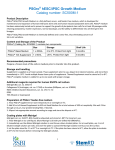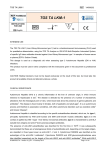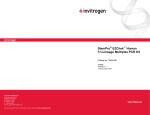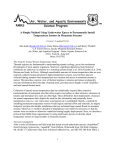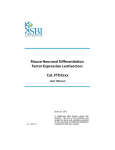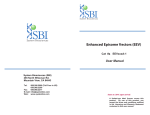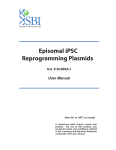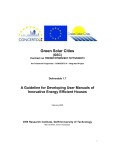Download FAQs Epi5 Episomal iPSC Reprogramming Kit Final
Transcript
Epi5™ Episomal iPSC Reprogramming Kit FA Qs Product Qty Cat. No. Epi5™ Episomal iPSC Reprogramming Kit 1 kit A15960 About Epi5™ Episomal iPSC Reprogramming Kit 1. What are induced pluripotent stem cells (iPSCs)? iPSCs are genetically reprogrammed somatic cells which exhibit a pluripotent stem cell–like state similar to embryonic stem cells. iPSCs can be derived by inducing selected gene expression via various methods. 2. What is the Epi5™ Episomal iPSC Reprogramming Kit? The Epi5™ Episomal iPSC Reprogramming Kit provides an easy-to-use, highly efficient set of 5 episomal vectors designed by Dr. Keisuke Okita in the laboratory of Professor Shinya Yamanaka at the Center for iPS Cell Research and Application (CiRA), Kyoto University. This system produces transgene-free, virus-free human induced pluripotent stem cells (iPSCs) with efficiencies in the range of 0.04% to 0.3%, depending upon the cell type being reprogrammed. 3. What vectors are included in the Epi5™ Kit? The Kit contains two tubes of vectors. One tube contains a set of 3 episomal plasmids that carry the reprogramming factors (Oct3/4, Sox2, Klf4, L-myc, and Lin28), and the second tube contains 2 plasmids that express the p53 dominant negative mutant (mp53DD) and EBNA1 genes. 4. How does the Epi5™ Kit work? The Epi5™ Kit vectors are introduced into the cell by electroporation. These non-integrating vectors replicate only once per cell cycle, with activation of replication by binding of multiple EBNA-1 homodimers to oriP within the nucleus (Thyagarajan et al., 2009). Visit lifetechnologies.com/epi5 for more product information, data, protocols, and troubleshooting tips or contact [email protected] for support. Epi5™ Episomal iPSC Reprogramming Kit FA Qs 5. What do the p53 dominant negative mutant and EBNA plasmids do? The p53 protein is highly involved in cell cycle regulation and tumor suppression. With the activation of cytotoxic responses, p53 expression results in cell cycle arrest or cell death to prevent further complications within the system. Knockdown of p53 has been shown to improve reprogramming efficiencies as well as to prevent differentiation via the introduction of a variety of knockdown agents (Hong et al., 2009; Spike & Wahl, 2011). The mp53DD is a dominant negative mutation of the p53 protein that provides higher efficiency knockdown than traditional shRNA systems (Kawamura et al., 2009). The presence of this gene in an episomal system allows for transient expression of the dominant negative mutant over an extended period of time, diluting out with normal passaging of iPSCs. 6. What is the difference between the Epi5™ Episomal iPSC Reprogramming Kit (A15960) and the Episomal iPSC Reprogramming Vectors (A14703)? The Epi5™ Kit contains vectors that express the Yamanaka factors (Oct3/4, Sox2, Klf4, L-myc, and Lin28) and vectors that enhance iPSC generation by suppressing p53 expression (Okita et al., 2011). The Episomal iPSC Reprogramming Vectors contain vectors that express the Thompson factors (Oct4, Sox2, Klf4, L-Myc, Lin28, and Nanog). 7. What are the benefits of using a viral-free reprogramming method? The Epi5™ Kit is a well-described system for producing transgene-free, virus-free iPSCs providing a source of iPSCs (Thyagarajan et al., 2009). Traditionally, direct reprogramming using multiple viral vectors generates iPSCs that contain many integrations of the viral vector, which could affect genetic function (Kaji et al., 2009). In general, DNA vectors are more stable than viral vectors, can be conveniently thawed and re-frozen through several usages prevent unwanted vector integrations, and offer a less hazardous method that is more amenable to an end goal involving regenerative medicine. 8. What are the benefits of using an integration-free reprogramming method? Integration-free reprogramming methods generate iPSCs that do not contain detectable vectors or transgenes. Traditional technologies used for reprogramming (e.g., lentivirus, retrovirus) integrate into the genome of the target cells. The resulting iPSCs and cells differentiated from those iPSCs will contain foreign DNA and could be unsafe and problematic for use in cell therapy and drug discovery applications. Furthermore, the integration could occur in a critical region of the genome, causing problems with unrelated developmental processes. 9. What cell types have been successfully reprogrammed with the Epi5™ Kit? iPSCs have been generated from a range of somatic cells including fibroblasts and CD34+ cells. Visit lifetechnologies.com/epi5 for more product information, data, protocols, and troubleshooting tips or contact [email protected] for support. Epi5™ Episomal iPSC Reprogramming Kit FA Qs 10. Can you reprogram mouse cells with this kit? The Epi5 kit was designed to reprogram human cells, not mouse cells. We currently only have data with this kit on reprogramming human cells, which aligns with the use of EBNA/oriP episomal vectors mainly in primate cells. Although rodent cells lack the oriP replicon and are not permissive, some studies replaced or modified oriP with other sequences to mediate replication and some literature reported the use of unmodified EBNA/oriP in certain hamster and mouse lines. 11. Are there safety concerns with the Epi5™ Kit? This product is safe for research purpose use only. How to use the Epi5™ Episomal iPSC Reprogramming Kit 12. How should I store the Epi5™ Kit? Upon receipt, store the kit at –15 to –25°C. For long-term storage, store plasmid vials at –68 to –85°C. 13. Can the Epi5™ plasmids go through multiple freeze/thaw cycles? The vectors can be frozen and re-thawed, however we recommend keeping freeze/thaw cycles to a minimum (2–3 cycles) by dispensing the vectors into aliquots and storing them at –15 to –25°C. 14. How many experiments can be performed with one kit? Each kit provides enough material to process 20 samples when transfecting 100,000 cells (using 10 μL per reaction) in a 6-well plate. Each vial of vectors in the kit contains 20 μL, and you will use 1 μL (from each vial) per experiment. 15. Can I omit the p53 dominant negative mutant and EBNA plasmids from my reprogramming experiment? We recommend that you use both the EBNA and p53 dominant mutant plasmids in your experiment. Our data, using fibroblasts on Geltrex® matrix-coated plates, show more colonies are produced when the vectors include both the p53 mutant and EBNA. If you omit the p53 mutant and EBNA plasmids, efficiency will be significantly reduced. Number of Colonies Plasmids Plasmids 1.3 + EBNA Plasmids Plasmids + EBNA 1.3 + p53 mutant 36 + p53 mutant 69.3 Visit lifetechnologies.com/epi5 for more product information, data, protocols, and troubleshooting tips or contact [email protected] for support. Epi5™ Episomal iPSC Reprogramming Kit FA Qs 16. How many cells do I need to start my reprogramming experiment with the Epi5™ Kit? For each reprogramming experiment using fibroblasts on Geltrex® matrix-coated plates and CD34+ cells, each transfection requires at least 1x106 cells. We recommend the following for fibroblasts, but this may vary with other cell types: Two to four days before transfection, plate cells into a T75 flask. Cells should be approximately 75–90% confluent on the day of transfection (Day 0). Depending on the seeding density and culture conditions, the cells may take up to 5 days to reach 75–90% confluency. Since overconfluency results in decreased transfection efficiency, we recommend replating your cells to achieve 75–90% confluency if they become overconfluent during culturing. 17. If I need to use a dish smaller than a T75 flask, what seeding density do I need to use? When seeding and transfecting fewer cells, both the number of cells and the volume of Epi5 vectors must be scaled accordingly. Because this can involve pipetting exceedingly small volumes, we recommend preparing a vector master mix to reduce pipetting error. For example, to transfect 50,000 fibroblasts, transfer 1 μL from Tube A and 1 μL from Tube B to a sterile vial for the vector master mix, and then pipette 1 μL of the master mix to your cells. 18. What is the optimal passage number for reprogramming patient fibroblasts? We recommend reprogramming patient cells at the earliest passage possible. However, it is important to have the cells growing and healthy, which can take between 1–4 weeks. The cells are usually ready to reprogram after completing a total of 3–4 passages. 19. Are small molecules required for reprogramming with the Epi5™ Kit? No, small molecules are not required. Visit lifetechnologies.com/epi5 for more product information, data, protocols, and troubleshooting tips or contact [email protected] for support. Epi5™ Episomal iPSC Reprogramming Kit FA Qs 20. What is the workflow for reprogramming fibroblasts with the Epi5™ Kit? The major steps required for reprogramming human neonatal foreskin fibroblast cells are shown below. Note that the timeline is provided as a guideline for experimental planning; the actual timeline can vary based on the cell type and experimental conditions. Day –4 to –2: Plate human fibroblasts into a T75 flask in Fibroblast Medium so that they are 75– 90% confluent on the day of transfection (Day 0). Day 0: Transfect the cells using the Neon® Transfection System. Plate transfected cells onto Geltrex® matrix-coated culture dishes, and incubate them overnight in complete Fibroblast Medium. Day 1 to 14: Change the medium to N2B27 Medium supplemented with 100 ng/mL bFGF; replace the spent medium every other day. Day 15: Change the medium to Essential 8™ Medium and monitor the culture vessels for the emergence of iPSC colonies. Day 21: Pick and transfer undifferentiated iPSCs onto fresh Geltrex® matrix-coated culture dishes for expansion. Visit lifetechnologies.com/epi5 for more product information, data, protocols, and troubleshooting tips or contact [email protected] for support. Epi5™ Episomal iPSC Reprogramming Kit FA Qs 21. What is the workflow for reprogramming CD34+ with the Epi5™ Kit? The major steps required for reprogramming StemPro® CD34+ cellsare shown below. Note that the timeline is provided as a guideline for experimental planning; the actual timeline can vary based on the cell type and experimental conditions. Day –3: Plate StemPro® CD34+ cells into a 24-well plate in complete StemPro®-34 medium containing cytokines (i.e., SCF, IL-3, and GM-CSF). Day 0: Transfect the cells using the Neon® Transfection System. Plate transfected cells onto Geltrex® matrix-coated culture dishes, and incubate them overnight in complete StemPro®-34 medium containing cytokines. Day 1: Change the medium to N2B27 Medium supplemented with 100 ng/mL bFGF; replace the spent medium every other day. Day 2 to 6: Replenish the culture every day by adding fresh medium. Day 7 to 8: Replace the spent medium with fresh medium every day. Day 9: Change the medium to Essential 8™ Medium and monitor the culture vessels for the emergence of iPSC colonies. Replace the spent medium every other day. Day 15 to 21: Pick and transfer undifferentiated iPSCs onto fresh Geltrex® Matrix-coated culture dishes for expansion. 22. Can I do reprogramming on feeders? While the Epi5™ Kit is optimized for feeder-free reprogramming, the user manual provides the steps required for reprogramming StemPro® CD34+ cells to generate iPSCs using the kit and the subsequent culture of the reprogrammed cells on MEF feeder layers. 23. What is the expected transfection efficiency when using Neon® Transfection System? Depending on the cell line/type, the expected transfection efficiency is between 0.04 and 0.3%. 24. Can I use lipids for transfection? We currently do not offer a lipid transfection protocol. Visit lifetechnologies.com/epi5 for more product information, data, protocols, and troubleshooting tips or contact [email protected] for support. FA Qs Epi5™ Episomal iPSC Reprogramming Kit 25. What is the expected percentage of cell death when transfecting with Neon® Transfection System? Cell death can be highly variable depending on cell type and cell health prior to transfection. We observe approximately 25% cell death post transfection with human neonatal foreskin fibroblasts (strain BJ) in the recommended conditions. 26. Can I use different electroporation systems? We have successfully tested the Amaxa® Nucleofector™ II system for electroporation by increasing the scale 10x for their 100-μL cuvette and plating cells on a 10-cm dish. We recommend following the OEM instructions if you choose to use a different electroporation system. 27. What is the recommended medium to use for my reprogrammed cells? For iPSCs, we recommend a feeder-free environment in Essential 8™ Medium on a Geltrex® matrixcoated dishes, or Vitronectin-coated dishes. 28. Are the episomal vectors selected out? Episomal vectors subsequently can be removed from cells by culturing the cells, resulting in a gradual loss of cellular episomal vectors from proliferating cells. 29. How can I verify the absence of episomal plasmids in my iPS clones? You can detect the presence of vectors in reprogrammed iPSC colonies by endpoint PCR using the primers listed below. The EBNA-1 primer set can detect all 5 episomal plasmids in the kit; the oriP primer set can detect all but the pCXB-EBNA1 plasmid, which lacks the OriP gene. Primers Transgene oriP EBNA-1 Primers Sequence pEP4-SF1-oriP 5'-TTC CAC GAG GGT AGT GAA CC-3' pEP4-SR1-oriP 5'-TCG GGG GTG TTA GAG ACA AC-3' pEP4-SF2-oriP 5'-ATC GTC AAA GCT GCA CAC AG-3' pEP4-SR2-oriP 5'-CCC AGG AGT CCC AGT AGT CA-3' Expected Size 544 bp 666 bp PCR Conditions Temperature Time Cycles Initial Denaturation Step 94°C 2 minutes — Denaturation 94°C 30 seconds Annealing 55°C 30 seconds Elongation 72°C 1 minute Final Elongation 72°C 7 minutes 35–40 — Visit lifetechnologies.com/epi5 for more product information, data, protocols, and troubleshooting tips or contact [email protected] for support. Epi5™ Episomal iPSC Reprogramming Kit FA Qs 30. Should differentiated material be removed prior to passaging? Newly derived PSC lines may contain a fair amount of differentiation through passage 4. It is not necessary to remove differentiated material prior to passaging. By propagating or splitting the cells, the overall culture health should improve throughout the early passages. Expected results with the Epi5™ Kit 31. How long does it take to see the iPSC colonies? You should be able to identify iPSC colonies by morphology roughly from 2 to 3 weeks posttransfection. 32. Why is there a wide range in the number of colonies obtained using this derivation technique? The wide range is due to the variability in the source of fibroblasts [neonatal vs. adult (commercial sources); neonatal vs. adult (patient biopsies)]; age of the donor/patient; and the type and number of reprogramming factors]. 33. How will my cells look after I use the Epi5™ Kit? Visit lifetechnologies.com/epi5 for more product information, data, protocols, and troubleshooting tips or contact [email protected] for support. Epi5™ Episomal iPSC Reprogramming Kit FA Qs Expected morphological changes as iPSC colonies emerge from human neonatal foreskin fibroblast cells (strain BJ) that were reprogrammed using the Epi5™ Kit are shown above. The phase contrast images were obtained at 5X magnification on Day 2, Day 6, and Day 21 post-transfection. 34. How can I identify iPSCs? The images below show the expected morphology of emerging iPSCs generated from human neonatal foreskin fibroblast cells (strain BJ). In these 5X magnification images, many large, nested colonies are visible. 35. How do I know when to passage the iPSCs? To maintain a healthy culture, iPSCs must be monitored and growth medium must be replaced daily. In general, iPSC colonies should be passaged when the cells reach 75–90% confluence or when most of the colonies are larger than 700 μm. 36. How can I verify that my iPSCs are pluripotent? To verify pluripotency, we recommend performing random differentiation using embryoid body formation. By Day 7, you can use the TaqMan® hPSC Scorecard™ Panel and/or at Day 21, you can perform staining. Visit lifetechnologies.com/epi5 for more product information, data, protocols, and troubleshooting tips or contact [email protected] for support. Epi5™ Episomal iPSC Reprogramming Kit FA Qs 37. Can I cryopreserve the iPSCs? You can cryopreserve iPSCs just as you would any other pluripotent stem cells. We recommend using a growth medium that contains 10% DMSO for freezing. References: Hong, H., Takahashi, K., Ichisaka, T., Aoi, T., Kanagawa, O., Nakagawa, M., Okita, K., and Yamanaka, S. (2009) Suppression of induced pluripotent stem cell generation by the p53-p21 pathway. Nature 460, 1132–1135. Kaji, K., Norrby, K., Paca, A., Mileikovsky, M., Mohseni, P., and Woltjen, K. (2009) Virus-free induction of pluripotency and subsequent excision of reprogramming factors. Nature 458, 771–775. Kawamura, T., Suzuki, J., Wang, Y. V., Menendez, S., Morera, L. B., Raya, A., Wahl, G. M., and Izpisua Belmonte, J. C. (2009) Linking the p53 tumour suppressor pathway to somatic cell reprogramming. Nature 460, 1140–1144. Okita, K., Matsumara, Y., Sato, Y., Okada, A., Morizane, A., Okamoto, S., Hong, H., Nakagawa, M., Tanabe, K., Tezuka, K., Shibata, T., Kunisada, T., Takahashi, M., Takahashi, J., Saji, H., and Yamanaka, S. (2011) A more efficient method to generate integration free human iPS cells. Nature Methods 8, 409–412. Spike, B. T., and Wahl, G. M. (2011) p53, Stem Cells, and Reprogramming: Tumor Suppression beyond Guarding the Genome. Genes Cancer 2, 404–419. Thyagarajan, B., Scheying, K., Xue, H., Fontes, A., Chesnut, J., Rao, M., and Lakshimipathy, U. (2009) A single EBV-based vector for stable episomal maintenance and expression of GFP in human embryonic stem cells. Regenerative Medicine 4(2): 239–250. For Research Use Only. Last updated 06 Dec 2013 © 2013 Life Technologies Corporation. All rights reserved. The Trademarks mentioned herein are the property of Life Technologies Corporation and/or its affiliate(s) or their respective owners. TaqMan is a registered trademark of Roche Molecular Systems, Inc., used under permission and license. Amaxa is a registered trademark of, and Nucleofector is a trademark of, Lonza Cologne AG. Essential 8 is a trademark of Cellular Dynamics International. Visit lifetechnologies.com/epi5 for more product information, data, protocols, and troubleshooting tips or contact [email protected] for support.












